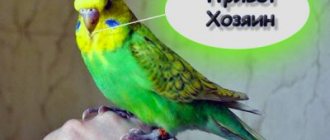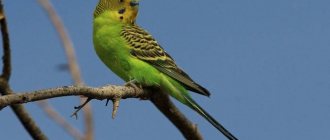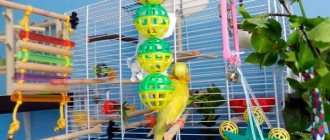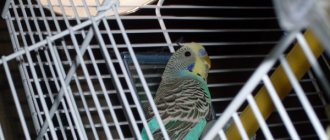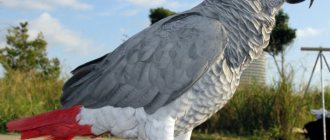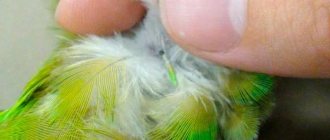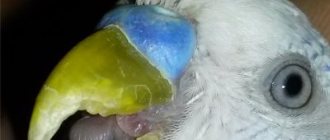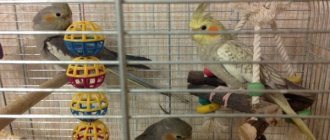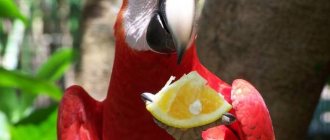Parrots are the only species of birds capable of remembering and reproducing human speech. Thanks to this feature, they are very popular among poultry lovers. But we must remember that their speech skills are not innate, but are acquired in the process of long-term training. In our article we will try to answer the question of how to teach a parrot to speak.
At what age is it better to learn to speak?
When deciding how to teach a budgerigar, cockatiel, gray parrot or other species to speak, you should always remember that young birds are more amenable to speech training. Teaching an adult parrot to speak words may not work. The optimal age for starting training is different for different types of parrots.
Budgerigars can be trained at 30-45 days of age. After 3-4 months of painstaking work, results can be obtained. The ideal age for training a cockatiel is 4-9 months. He learns faster than the wavy ones.
Gray parrots can begin to be trained in the age range of 3 to 9 months. By the way, this is the most capable representative of the entire extended family for learning speech. True, keeping it at home is more difficult than cockatiels or wavy birds.
Can a bird start talking at home?
Budgerigars are not the only birds in the world that can speak using human sounds and putting them into words.
At the same time, many other species of parrots can do this better and much more consciously.
However, budgerigars are the most common and suitable for home keeping, so many of their owners are concerned about the possibility of teaching the bird to talk.
If we approach this issue with all rigor, then the sounds of budgies cannot be called a conversation. This is just an imitation of what was previously heard. With the same success, parrots can imitate other sounds they like.
To teach a budgie, it is not enough that it simply hears everyday human speech, although some birds are capable of this. To achieve the result desired by the owner, the parrot needs to be dealt with purposefully.
It should be noted that feathered pets can have both different personalities and different learning abilities. Thus, if a bird is not inclined to talk, then it is almost impossible to teach it.
It is almost impossible to determine at the time of purchase whether the pet will be talkative or not. These will become clear only from the results of classes with her. At the same time, it should be noted that the gender and age of the pet indirectly influence learning abilities, which will be discussed later.
What types of parrots learn faster?
The fastest-learning varieties of parrots include:
- Amazon. Experts believe that these birds learn spoken language faster than all other large representatives of the family. They are able to remember and reproduce 50-60 words.
- Budgerigars are the fastest learning small species. Vocabulary is often limited to 10-20 words, pronunciation is unclear.
- Corella. Talking cockatiels are very popular among bird lovers. On average, their vocabulary reaches several dozen words.
- Macaw. The vocabulary is very low - up to 20 words. But scientists have found that macaws are the smartest of the parrots. They are able to connect words and events, build an associative chain of thinking.
- Cockatoo. Speech training of representatives of this genus leads to the fact that birds begin to pronounce words well and legibly. Their vocabulary can include up to several dozen words.
- Jaco. If a bird lover wants to get a 100% talking parrot, then this is the choice for him. These birds are distinguished by the most developed speech abilities of all members of the family. They can remember and reproduce over 100 words and speak in phrases. The intellectual level of the Gray Gray is very high and corresponds to the level of a five-year-old child.
Amazon
These cuties can rightfully be considered the most trainable large birds in the world. On average, birds of this species remember from 50 to 60 words, but there are also outstanding specimens that can use a set of up to 300 words.
They pronounce the words that the Amazons use very clearly and legibly, but, unfortunately, they cannot reproduce the timbre and intonation of a person.
It will be surprising that these birds recognize a person’s reaction to spoken words and engage in self-education. Words that are least interesting to a person will be replaced with new ones over time, in the context of recent events or conversations.
Amazons, unlike the previous type of parrot, have bright and beautiful plumage. The color varies slightly within a basic green, with splashes of blue, white, red and yellow.
In terms of mastering a new home, in relation to the Gray, this is the complete opposite. Amazons don’t get offended, don’t throw tantrums, and don’t pluck feathers for any reason they don’t like. These birds very quickly become attached to people and do not look for the leader of their pride, but treat all family members cordially, who pay the parrot the due amount of attention.
Like the Gray, Amazon can be bought as an already trained polyglot, or as a young and modest stand-up comedian. The difference in price will be exactly the same as for Grays. Just like for a Gray, for such a handsome man you will need to pay the seller about a thousand green American rubles.
Who is more capable - males or females?
Many years of practical experiments and observations show that males learn to speak faster than females and have a larger vocabulary. This is due to the fact that their vocal cords are much more developed. In the wild, boys have to sing quite often, including during mating games. So, if a person wants to buy a parrot that will speak well, he should focus on the gender of the bird he is purchasing.
But speech training of females is not at all a hopeless task. Despite the fact that girls study longer and have a smaller vocabulary, they pronounce words much more clearly. So you don’t have to think long about whether it is possible to teach a female budgerigar to speak. We need to start the process.
How to choose a bird
Not all birds speak and are able to clearly reproduce human speech. Sometimes the owner's persistent efforts end in nothing. To achieve the desired result and teach your pet to speak, you need to choose the most capable one from dozens of parrots. Here are some basic criteria for choosing a wavy talker:
Chick age
The sooner a bird begins to live next to a person, the greater the chance of teaching it at least some words. There is an opinion that a parrot, which at a young age was deprived of communication with its relatives (ideally, immediately after leaving the nest, that is, a month after birth), gradually begins to consider itself a member of the family and imitate human speech.
Another way to imprint yourself in your parrot's mind as a mentor and role model is to save the bird in an extreme situation. For example, to warm it in winter or save it from the claws of a cat. But such situations are already risky for the life of a feathered pet. By the way, it is for this reason that weak chicks that need special attention and care are in high demand.
Gender of the chick
It has been observed that males are more capable of speech than females. Green or blue parrots learn to speak especially quickly. But this does not mean that girls are dumber. They remember and listen to words for a long time, but then speak much louder and more clearly than boys.
You can distinguish the sex of a bird at an early age by the growth that is present above the beak. If the parrot is an adult, then a bright blue bump is a sign of a male, and a fawn or brown one is a sign of a female. In young males the growth is bluish-white, while in girls it is white with a gray or blue tint.
Natural abilities
Parrots, like humans, have genetic memory. If the parents of the selected chick were talking or were able to reproduce surrounding sounds (the sound of water, music, steps), then its chances of mastering articulate speech increase significantly.
Trust in a person
It is worth paying attention to how the chick reacts to the people around it. For tamed parrots, training is easier and faster, as they trust their owner. If the chick in the cage is active, shows interest in the outside world, and easily falls into the hands of a person, then you can safely buy it.
The age of a chick can be determined by external signs. Juvenile birds have a short tail, large dark eyes and a dark beak. The feathers of the chick are matte, do not shine, and waviness is present over the entire surface of the plumage from the supra-beak growth to the back. With age, the wavy disappears up to the middle of the head, the beak acquires a lighter shade, and a light ring can be seen around the pupil.
These are the basic rules that should be followed when choosing a talking bird. If you are careful, an individual suitable for training can easily be distinguished from the background of other parrots.
The key to fast and high-quality training
When solving the question of how to teach a parrot to talk in practice, you must adhere to some rules, otherwise the result of the process will be negative.
Regular classes
To teach your pet to speak, you need to work with it systematically. Lessons should take place every day and take approximately 15-25 minutes. Once a week you can conduct a kind of control session lasting 35-45 minutes.
Insulation
Experts recommend isolating a parrot whose owner wants to teach him to speak. Neighbors in the cage make it difficult to concentrate and distract the bird’s attention during lessons. Some experts recommend removing unnecessary toys and accessories from the cage.
Nothing should distract the pet's attention from activities, otherwise achieving the goal is not guaranteed.
No stress
The atmosphere during classes should be calm and friendly. The bird should not be afraid of anything, otherwise a good result may not be expected. Therefore, you can only train parrots that have already adapted to their living conditions.
It is worth mentioning separately:
- Inadmissibility of punishment. Their use will have the completely opposite effect.
- The need to conduct a lesson only in a good mood. Birds feel the emotions of their owners. A person’s manifestation of irritability will not go unnoticed. Psychological contact with a feathered pupil can be hopelessly damaged.
Motivation
Motivation is extremely important in the learning process. You can achieve a positive attitude in your parrot and a desire to learn new words by giving him a treat every time after successfully completing a task.
Patience
Patience and work will grind everything down, says a Russian folk proverb. This fully applies to the training of parrots. The person handling the bird should not try to force things too much. He should not abandon the process after the pet’s first failures. All difficulties will be overcome after persistent and systematic work.
Advice for future owners of a talking parrot:
- You need to determine for yourself how much you are willing to spend on purchasing a bird. Decide whether you have the patience to learn his words or whether it is better to purchase an adult talking parrot. Keep in mind that a young bird costs half as much and you can teach it to say what you want.
- It is impossible to determine a bird's abilities in advance. But persistence and patience will give results in any case.
- You need to make friends with the parrot. Treat it kindly, do not tease or frighten it, otherwise the bird will not make contact.
- It is better to conduct short lessons (10-15 minutes each) than one long lecture. Observe the reaction: when the “student” listens carefully and perceives information, the pupils dilate and contract.
- The room should be quiet during classes. More productive classes will be held in the morning and sunset hours.
- First, you should learn simple short words. The first words should contain the vowels “o” and “a” and the consonants “r”, “p”, “k”, “t”. Afterwards you can move on to more complex material.
- Parrots remember words with increased emotionality better - questions, exclamations, greetings.
- Parrots perceive children's and women's voices faster than men's.
- Can be used to teach CD recording.
Remember that among representatives of any breed there can be both mediocrity and especially gifted specimens. The success of your choice will largely depend on the bird itself and your efforts. Don't buy a parrot solely because you want a talking parrot. Parrots, in addition to their possible “linguistic” talent, have other good qualities that make them good household members.
How to teach a parrot to pronounce sounds clearly
When training a budgerigar, you may encounter the fact that the bird speaks unclearly. The same problem exists in other species. There are two reasons for its occurrence:
- The teacher himself has unclear pronunciation. In this case, he needs to think about how to adjust his diction.
- Lack of speech practice in birds. In this situation, you need to think about how best to organize activities with your pet.
Patience and hard work by the trainer with the pet and on himself will definitely lead to a positive result.
What should the owner do
To successfully train budgerigars to speak humanly, the owner must adhere to certain behavioral tactics.
First: comfortable conditions
When transporting your pet, it is better to cover the cage with a cloth or place the bird in a box with slots. Street noises and flashes of strangers can greatly frighten the bird. Sometimes young chicks even die from fear.
It is better to prepare a cage for permanent maintenance in advance. The success of the training depends on how comfortable the budgie feels in its new home. The cage can be wire, but high. Regardless of whether it is new or not, the parrot's apartment must be washed with soap or scalded with boiling water. The bottom of the cage is covered with newspaper, and the perches are fixed at different heights.
It is better to make wooden parts from linden, maple or birch. Such a swing will serve not only as entertainment for the bird, but also as a place for sharpening its beak. But you should not clutter the cage with additional devices so that the new resident can move relatively freely.
Second: there must be one teacher
When a chick just arrives at a new place of residence, one person should be involved in its training and upbringing. But this is ideal. The owner who will take care of the budgie, feed it and play, in the mind of the bird acquires the status of a member of the flock. Then the speed of learning will depend only on the time that a person can spend communicating with the pet.
It is also worth considering that the bird’s high tones speak much more easily. That is why the first sounds that a talker begins to imitate are the voice of a small child or a woman. Male voices are also reproduced quite quickly if they sound in a high octave.
Third: privacy
During training, it is better to keep budgies in a quiet and calm environment. You must turn off the TV and radio in the room. It is also worth removing the mirror from the cage for a while, otherwise the bird will be constantly distracted. But after class the mirror is returned. In the absence of an interlocutor, the parrot will talk to its reflection and repeat to it all the words it has learned.
Some teachers cover the cage with a dark, opaque cloth, believing that this helps the child concentrate. This is not true. The constant lack of light causes depression in parrots and even leads to serious illnesses.
Fourth: the right moment
It is impossible to force a wavy pet to listen to a lesson. Classes are held only when the parrot is in the mood for communication. This can be achieved by turning learning into a fun game. Therefore, birds are always brought in one at a time. When paired, they are busy with each other and show no interest in human speech.
When communication with a girlfriend is impossible, the person becomes the only interlocutor to whom the chick listens carefully. And over time, the desire to talk will take its toll, and the parrot will begin to imitate everything that the owner says.
Fifth: teaching methodology
All words and phrases spoken by the teacher must be meaningful and tied to a specific action. Saying that Gosha is good, you can pat your pet on the head and caress him. The treat should be accompanied by words about food, with the same phrase or expression repeated several times. Words should be short, no more than two syllables, and the timbre of the voice should be high, but gentle. Then the talker will learn phrases in relation to a specific situation and will pronounce them more meaningfully.
The first thing that talking birds say is their own nickname or the name of the owner. Greetings and requests are also well remembered. In addition to simple speech, some pets can be taught to read poetry or sing songs. Therefore, you should not swear in the presence of a wavy pet. These words are short, easy and quickly reproduced by even the most unsociable chicks.
Parrots show interest by clicking their beaks, looking into the owner's mouth, and feathers fluffed up with happiness. When such signs are present, it means that the path to success has been chosen correctly. If the TV is on all the time in a parrot's room, then the bird stops paying attention to human speech and perceives it as background noise.
Sixth: encouragement
The whip method in training parrots is unlikely to produce results. But the gingerbread method is really effective, this has been proven in practice many times. All your pet's successes should be marked with a treat, especially if the word or phrase is pronounced correctly and in a timely manner.
And don’t forget, your pet needs your attention and affection not only during classes. Learning will be easier if emotional contact is established between man and bird. And this is only possible with constant and trusting communication.
A parrot is a wonderful pet because it requires minimal attention and effort to care for. However, parrots have another advantage - they can be taught to talk. We will talk about how to do this correctly in our article today. But before that, it’s worth considering that if your parrot is a female, then you are unlikely to teach her to talk.
Here are some answers (tips) to frequently asked questions about how to teach a parrot to talk, following which you will teach your pet to talk quickly.
Errors in learning
- Unsystematic activities. Irregular lessons do not bring the desired result, but lead to disappointment. The bird simply does not remember the material taught to it. Speech abilities simply do not develop with such an organization of classes.
- Conducting a lesson in a bad mood. This leads to psychological breakdowns in the teacher, which leads to stress for the parrot and loss of contact with him. And without contact with the student, no educational process is possible. It will simply turn into torment for both the teacher and the student.
- Use of punishments. The bird simply does not understand their meaning and they are interpreted as hostile actions. The result is rejection from the person. The planned result is unlikely to be fully achieved.
Teaching a budgie to talk
First, you should get to know the bird and win it over. Your “lessons” in learning to talk depend on how quickly you establish contact with her.
After you notice that the wavy has become comfortable: it eats calmly, looks at surrounding objects with interest and makes some sounds, you can begin to tame the baby.
Trust is the basis of your future friendship and the first step to contact with your parrot's personality.
Each time you approach the cage, say the baby’s name in a calm and gentle voice. Try to keep the cage close to the place where you spend the most time. You will be in the bird's field of view and will be able to contact it periodically. In addition to the parrot's name, say "hello" when you enter the room where your feathered friend lives and "bye" when you leave.
Conduct lessons in a calm environment without distracting objects or strangers. A parrot that is not yet completely comfortable will not be able to relax normally and listen to your words.
It is desirable that the name of the wavy contains hissing sounds - birds sympathize with similar ones and imitate them exceptionally well, the drawn-out sounding sound “r” also encourages the bird to repeat.
You can try having regular lessons at the end of the day at the same time. Before sunset, the bird usually behaves more calmly and can more easily concentrate its attention on you.
Budgerigars are good at “linking” actions and words. When treating a bird to an apple, you can bring a piece to your mouth, imitating eating and exclaim: “delicious!” In the future, if you want to treat the wavy with some new fruit or herbs, all you have to do is say this word.
You can use other words that are convenient for you and sound attractive to your feathered friend. The main thing is to clearly pronounce each letter and pronounce the word being taught more often.
Approach the cage and gently say the name and endearing epithets. Gradually, the parrot, when it sees you, will move to the nearest wall of the cage and listen to your conversation.
Don’t expect your baby to immediately start putting in his own words. Even a budgerigar that is already talking will shut up and listen when it hears you.
Do not immediately burden the bird with an abundance of phrases; at first it will be enough to say: “Tosha or Tosha is good,” and not “Tosha is such a good boy.” Although in the future, the words: “what, such” will also firmly enter the parrot’s vocabulary - they will be happy to insert them everywhere during a conversation.
Birds love rewards in the form of a piece of carrot, dandelion leaf or lettuce. Maintain your contact with various treats.
But since everything is very individual, consider these tips through the prism of your lifestyle and the character of your particular budgie.
How to conduct lessons correctly?
In order for lessons on teaching a parrot to speak more effectively, several basic rules should be followed:
- Conduct lessons with only one parrot in a room where no one else will be;
- In order not to confuse your parrot, you should not teach him several words at once, which may be difficult for him;
- Training lessons should be conducted for no more than 40 minutes at a time, but can be done several times a day;
- After pronouncing a word that the parrot needs to learn, reward it with a treat;
- If your pet becomes distracted, you should not continue the activity so that he does not become overtired.
- If, after a person pronounces words, a parrot begins to try to repeat individual sounds, this is a good result. This means that learning is possible and soon the parrot will be able to speak.
Answers to frequently asked questions
What words are best to learn with a bird?
As for what words, phrases and expressions you can teach your budgie, you should always start with easy material. That is, the bird should be taught simple words. As a rule, they begin to teach budgies to speak by learning the bird's name or simple words consisting of two syllables , such as “Hello.” To begin with, select short words that contain sounds: “r”, “ch”, “sch”, “sh”. If you can somehow emotionally interest a bird with a three-syllable word and make the bird want to learn it, then why not. If the bird really wants to, then even at the initial stage it will be able to master a more complex word of three syllables, such as “gorgeous,” and in the future will actively use it in its speech.
Is it possible to diversify the vocabulary of budgerigars and how to do it?
Yes, you can teach them to say more words as budgies have a very good memory. Literally after the first few words learned, it will be possible to simultaneously teach the bird two or more words. This will help you see which phrases your feathered friend likes more and which ones less. Based on this, you can adjust the training program for your talking budgie.
Can a talking budgie forget all its words?
Undoubtedly! If the parrot does not practice , then gradually he will lose his skills. The clarity of pronunciation of words will become worse and worse each time. Ultimately, this will lead to the fact that the pet will no longer be able to pronounce the words it once learned. To prevent this from happening, we need to talk. So regularly repeat the words you have covered.
Another situation may arise. You trained a parrot who lived alone. Over time, you acquired other parrots and placed them all together . If in this case your budgerigar has become silent, this is due to the fact that he finally has the opportunity to communicate with his relatives in his native language. They will probably only speak to each other in birdlike for a while.
What if the budgie doesn’t say anything other than muttering?
Is it possible to teach such budgies to speak? Will there be progress? Apparently, the fact that your feathered pet is mumbling is a little progress . This means that you have moved on and are somewhere halfway to complete mastery of the word. Therefore, do not stop conducting classes under any circumstances! Be patient, and very soon your pet will be able to clearly pronounce the word being studied.
How many words can a budgie learn?
If you work hard with your parrot, he will be able to remember dozens of words and will even combine them into sentences. Even though such capable polyglots may come up with meaningless sentences, they are very funny and undoubtedly amuse the owners. There are also silent parrots. They prefer to just tweet. Thus, not everything depends on a competent approach to classes. Much is also influenced by the predisposition and character of the pet itself.
When to start learning
Wanting to teach their pet to talk, many owners make the extremely serious mistake of starting to actively engage in this immediately after purchasing the bird . This is the wrong tactic.
The fact is that arriving and staying in a new home poses significant stress for a pet. Parrots need some time to adapt and get used to new living conditions. Naturally, conducting a lesson during this period is fruitless.
Is your parrot tame?
Not really
On average, the adaptation time for birds is about two weeks. However, in practice, all birds are different in their temperament and adaptive abilities. Therefore, for some, the adaptation period may end in a few days, while for others it lasts more than one month.
As for the optimal age when a bird can learn to talk, it should be understood that the younger the pet, the better learning abilities it has.
Young budgerigars aged 1 to 4 months learn best.
